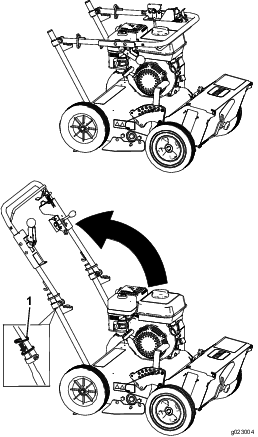| Maintenance Service Interval | Maintenance Procedure |
|---|---|
| Before each use or daily |
|
Introduction
This machine seeds turf. It is intended for small- to medium-sized lawn applications in residential and commercial properties.
Read this information carefully to learn how to operate and maintain your product properly and to avoid injury and product damage. You are responsible for operating the product properly and safely.
You may contact Toro directly at www.Toro.com for product safety and operation training materials, accessory information, help finding a dealer, or to register your product.
Whenever you need service, genuine Toro parts, or additional information, contact an Authorized Service Dealer or Toro Customer Service and have the model and serial numbers of your product ready. Figure 1 illustrates the location of the model and serial numbers on the product. Write the numbers in the space provided.
Important: With your mobile device, you can scan the QR code on the serial number decal (if equipped) or visit www.Toro.com to access warranty, parts, and other product information.
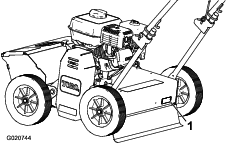
This manual identifies potential hazards and has safety messages identified by the safety-alert symbol (Figure 2), which signals a hazard that may cause serious injury or death if you do not follow the recommended precautions.

This manual uses 2 words to highlight information. Important calls attention to special mechanical information and Note emphasizes general information worthy of special attention.
This product complies with all relevant European directives; for details, please see the separate product specific Declaration of Conformity (DOC) sheet.
Warning
CALIFORNIA
Proposition 65 Warning
The engine exhaust from this product contains chemicals known to the State of California to cause cancer, birth defects, or other reproductive harm.
It is a violation of California Public Resource Code Section 4442 or 4443 to use or operate the engine on any forest-covered, brush-covered, or grass-covered land unless the engine is equipped with a spark arrester, as defined in Section 4442, maintained in effective working order or the engine is constructed, equipped, and maintained for the prevention of fire.
The enclosed engine owner's manual is supplied for information regarding the US Environmental Protection Agency (EPA) and the California Emission Control Regulation of emission systems, maintenance, and warranty. Replacements may be ordered through the engine manufacturer.
Safety
Improperly using or maintaining this machine can result in injury. To reduce the potential for injury, comply with these safety instructions and always pay attention to the safety-alert symbol, which means Caution, Warning, or Danger—personal safety instruction. Failure to comply with these instructions may result in personal injury or death.
Safe Operating Practices
Training
-
Read the Operator's Manual and other training material. If the operator(s) or mechanic(s) can’t read English, it is the owner's responsibility to explain this material to them.
-
Become familiar with the safe operation of the equipment, operator controls, and safety signs.
-
All operators and mechanics should be trained. The owner is responsible for training the users.
-
Never let children or untrained people operate or service the equipment. Local regulations may restrict the age of the operator.
-
The owner/user can prevent and is responsible for accidents or injuries occurring to himself or herself, other people or property.
Preparation
-
Evaluate the terrain to determine what accessories and attachments you need to properly and safely perform the job. Use only accessories and attachments approved by the manufacturer.
-
Wear appropriate clothing including eye protection, long plants, substantial slip-resistant footwear, and hearing protection. Tie back long hair and do not wear loose clothing or loose jewelry.
-
Inspect the area where you will use the equipment and remove all objects such as rocks, toys, and wire, which can be contacted by the machine.
-
Check that the operator-presence controls, safety switches, and shields are attached and functioning properly. Do not operate unless they are functioning properly.
Fuel Safety
-
Use extra care when handling fuel. It is flammable and its vapors are explosive.
-
Extinguish all cigarettes, cigars, pipes, and other sources of ignition.
-
Use only an approved fuel container.
-
Do not remove the fuel cap or fill the fuel tank while the engine is running or hot.
-
Do not add or drain fuel in an enclosed space.
-
Do not store the machine or fuel container where there is an open flame, spark, or pilot light, such as on a water heater or other appliance.
-
If you spill fuel, do not attempt to start the engine; avoid creating any source of ignition until the fuel vapors have dissipated.
Operation
-
Use your full attention while operating the machine. Do not engage in any activity that causes distractions; otherwise, injury or property damage may occur.
-
Never run an engine in an enclosed area.
-
Operate the machine only in good light, keeping away from holes and hidden hazards.
-
Start the engine only from the operator’s position.
-
Never operate without the shields, covers, or other guards securely in place. Ensure that all interlocks are functioning properly.
-
Do not change the engine governor setting or overspeed the engine.
-
Raise the cutting blades, stop the machine, and shut off the engine before leaving the operator’s position for any reason.
-
Stop the machine, shut off the engine, wait for all moving parts to stop, and inspect the cutting blades after striking an object or if an abnormal vibration occurs. Make necessary repairs before resuming operation.
-
Keep your hands and feet away from the cutting blade area.
-
Keep bystanders, especially small children, out of the operating area. Stop the machine if anyone enters the area.
-
Be alert, slow down, and use caution when making turns. Look behind and to the side before changing directions.
-
Slow down and use caution when crossing roads and sidewalks.
-
Do not operate the machine while ill, tired, or under the influence of alcohol or drugs.
-
Lightning can cause severe injury or death. If lightning is seen or thunder is heard in the area, do not operate the machine; seek shelter.
-
Use extreme care when loading or unloading the machine into a trailer or truck.
-
Use care when approaching blind corners, shrubs, trees, or other objects that may obscure vision.
-
Always be aware of obstacles that may be in the area of operation. Plan your path to avoid contact with any obstacle by you or the machine.
Slope Safety
-
Use the machine across the face of slopes; never up and down. Use extreme caution when changing direction on slopes.
-
Do not use the machine on excessively steep slopes. Poor footing could cause a slip-and-fall accident.
-
Use the machine with caution near drop-offs, ditches, or embankments.
Maintenance and Storage
-
Park the machine on a level surface, shut off the engine, and wait for all movement to stop before adjusting, cleaning, or repairing. Raise the cutting blades, stop the machine, shut off the engine, and disconnect the spark-plug wire.
-
Clean grass and debris from the blades, drives, mufflers, and engine to help prevent fires. Clean up oil or fuel spills.
-
Let the engine cool before storing and do not store the machine near a flame.
-
Shut off the fuel while storing or transporting the machine on trailers. Do not store fuel near flames or drain indoors.
-
Never allow untrained personnel to service the machine.
-
Use jack stands or safety latches to support components when required.
-
Carefully release pressure from components with stored energy.
-
Remove the spark-plug wire before making any repairs.
-
Keep your hands and feet away from moving parts. If possible, do not make adjustments with the engine running.
-
Keep all parts in good working condition and all hardware tightened. Replace all worn or damaged decals.
-
To best protect your investment and maintain optimal performance of your Toro equipment, count on Toro genuine parts. When it comes to reliability, Toro delivers replacement parts designed to the exact engineering specifications of our equipment. Use only Toro genuine parts.
Safety and Instructional Decals
 |
Safety decals and instructions are easily visible to the operator and are located near any area of potential danger. Replace any decal that is damaged or missing. |



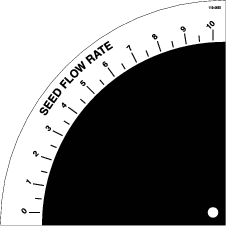

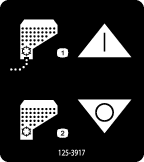
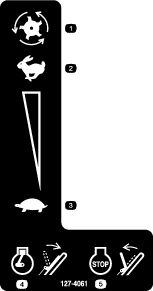



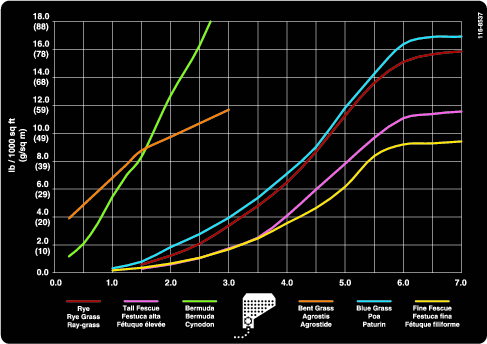
Setup
Unfolding the Handle
Checking the Engine-Oil Level
The machine comes from the factory with oil in the engine crankcase; however, you may need to add oil. Refer to Checking the Engine-Oil Level. Add only enough oil to raise the level to the Full mark on the dipstick.
Product Overview

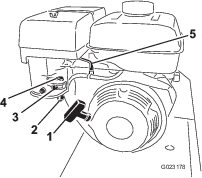
Recoil-Start Handle
To start the engine, pull the recoil-start handle (Figure 5) quickly to turn the engine over. Refer to Starting the Engine for the correct starting procedure.
Fuel-Shutoff Valve
Close the fuel-shutoff valve when transporting or storing the machine (Figure 5).
Choke Lever
Before starting a cold engine, move the choke lever forward. After the engine starts, regulate the choke to keep the engine running smoothly. As soon as possible, move the choke lever all the way rearward.
Note: A warm engine requires little or no choking.
Throttle Lever
Move the control forward to increase the engine speed and rearward to decrease speed; refer to Figure 6.
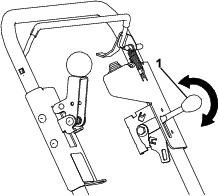
Operator-Presence Bail
The operator-presence bail allows the machine to start and run.
-
To start the machine, hold down the operator-presence bail (Figure 7). Continue to hold down the operator-presence bail to allow the machine to run.

-
To stop the cutting blades, release the operator-presence bail.
Depth-Control Lever
The depth-control lever allows you to set the depth of the cutting blades in 10 cutting positions along with 1 position for transportation. To adjust the depth, remove the hairpin cotter, pull the locking pin out, and move the lever forward or rearward to the desired depth setting (Figure 8).
Important: Do not pull the lever side to side as this will bend it.
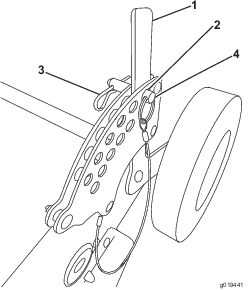
Seeding-Rate Gauge
Use the seeding-rate gauge to set the seed flow rate. It is calibrated with the machine speed to give you an even seeding rate at any speed. To change the seeding rate, loosen the knob on the gauge and move the gauge pointer to the desired position, then tighten the knob to hold it in place.
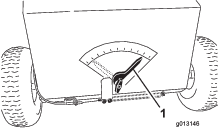
Refer to the seeding graph located on the machine to determine the correct gauge setting for the type of grass you are planting and the thickness in which you want to plant it.
Seed-Gate-Control Lever
Push the seed-gate-control lever (Figure 10) forward to start the seed flow, and pull it rearward to stop the seed flow.
Note: The machine is designed so that the seed flow slows and/or stops when you stop the machine or slow for a turn. To reduce seed loss, raise the front wheels as the machine is turned. There is no need to turn the seed flow on and off for each turn.
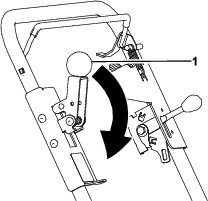
Note: Specifications and design are subject to change without notice.
| Width | 70 cm (27.5 inches) |
| Length (operating) | 130 cm (51 inches) |
| Length (with handle stored) | 96.5 cm (38 inches) |
| Height (operating) | 94 cm (37 inches) |
| Height (with handle stored) | 63.5 cm (25 inches) |
| Weight | 77 kg (170 lb) |
Attachments/Accessories
A selection of Toro approved attachments and accessories is available for use with the machine to enhance and expand its capabilities. Contact your Authorized Service Dealer or Distributor or go to www.Toro.com for a list of all approved attachments and accessories.
Important: Use only Toro approved attachments. Other attachments may create an unsafe operating environment or damage the machine.
To best protect your investment and maintain optimal performance of your Toro equipment, count on Toro genuine parts. When it comes to reliability, Toro delivers replacement parts designed to the exact engineering specification of our equipment. Use only Toro genuine parts.
Operation
Note: Determine the left and right sides of the machine from the normal operating position.
Adding Fuel
Fuel Safety
-
Use extra care when handling fuel. It is flammable and its vapors are explosive.
-
Extinguish all cigarettes, cigars, pipes, and other sources of ignition.
-
Use only an approved fuel container.
-
Do not remove the fuel cap or fill the fuel tank while the engine is running or hot.
-
Do not add or drain fuel in an enclosed space.
-
Do not store the machine or fuel container where there is an open flame, spark, or pilot light, such as on a water heater or other appliance.
-
If you spill fuel, do not attempt to start the engine; avoid creating any source of ignition until the fuel vapors have dissipated.
Recommended Fuel
-
For best results, use only clean, fresh (less than 30 days old), unleaded gasoline with an octane rating of 87 or higher ((R+M)/2 rating method).
-
Ethanol: Gasoline with up to 10% ethanol (gasohol) or 15% MTBE (methyl tertiary butyl ether) by volume is acceptable. Ethanol and MTBE are not the same. Gasoline with 15% ethanol (E15) by volume is not approved for use. Never use gasoline that contains more than 10% ethanol by volume, such as E15 (contains 15% ethanol), E20 (contains 20% ethanol), or E85 (contains up to 85% ethanol). Using unapproved gasoline may cause performance problems and/or engine damage which may not be covered under warranty.
-
Do not use gasoline containing methanol.
-
Do not store fuel either in the fuel tank or fuel containers over the winter unless you use a fuel stabilizer.
-
Do not add oil to gasoline.
Using Stabilizer/Conditioner
Use a fuel stabilizer/conditioner in the machine to provide the following benefits:
-
Keeps fuel fresh during storage of 90 days or less (drain the fuel tank when storing the machine for more than 90 days)
-
Cleans the engine while it runs
-
Eliminates gum-like varnish buildup in the fuel system, which causes hard starting
Important: Do not use fuel additives containing methanol or ethanol.
Add the correct amount of fuel stabilizer/conditioner to the fuel.
Note: A fuel stabilizer/conditioner is most effective when mixed with fresh fuel. To minimize the chance of varnish deposits in the fuel system, use fuel stabilizer at all times.
Filling the Fuel Tank
-
Park the machine on a level surface, disengage the cutting blades, stop the engine, wait for all moving parts to stop, and turn the engine switch to the OFF position.
-
Allow the engine to cool.
-
Clean around the fuel-tank cap and remove it (Figure 11).
Note: The cap is tethered to the fuel tank.
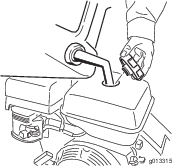
-
Add unleaded fuel to the fuel tank until the level is just inside the mesh filter basket.
Important: This space in the tank allows fuel to expand. Do not fill the fuel tank completely full.
-
Install the fuel-tank cap securely.
-
Wipe up any spilled fuel.
Starting the Engine
-
Move the choke lever to the left if you are starting a cold engine.
-
Move the throttle lever midway between the SLOW (turtle) and FAST (rabbit) positions.
Note: A warm or hot engine may not require choking.
-
Hold down the operator presence bail with one hand.
-
Pull the recoil handle sharply to start the engine.
-
After the engine starts, gradually move the choke to the right.
Note: If the engine stalls or hesitates, move the choke left again until the engine warms up.
-
Move the throttle lever to the desired setting.
Stopping the Engine
-
Release the operator-presence bail.
-
Close the fuel valve.
-
Wait for all moving parts to stop.
Operating the Machine
-
Move the depth control lever to the desired setting.
-
Start the engine.
-
Push down on the handle to raise the front wheels off the ground.
-
Pull the cutting-blade-control lever to the handle, and slowly lower the front wheels to the ground, allowing the blades to gradually work into the grass and soil.
-
When finished, release the cutting-blade-control lever, shut off the engine, and raise the cutting blades to the transport setting.
Cleaning Debris from the Machine
-
Disengage the cutting blades, shut off the engine, wait for all moving parts to stop, and turn the engine switch to the OFF position.
-
Brush dirt and debris away from the air cleaner and engine openings.
Operating Tips
-
As seed flow varies greatly between different seed types, fill the hopper with a minimal amount of seed, and run a trial portion of the yard to ensure you have the desired seed output.
-
For optimal coverage, reduce the seed flow to 1/2 the desired amount and seed the entire yard in 1 direction, then complete a second coverage perpendicular to the first.
Power Seeding
-
Set the cutting blades 3 to 6 mm (1/8 to 1/4 inch) into the earth (below the zero position).
-
Mow the lawn shorter than normal mowing length before seeding.
-
Seed the lawn before prime grass growing season.
-
Give the lawn extra watering after seeding.
Power Raking/Renovating
To break new ground or till an existing lawn, set the cutting blades 6 to 12 mm (1/4 to 1/2 inch) into the earth (below the zero position). Allow the machine to move at its own pace through the soil, going forward and backward over the area to be leveled, or making multiple passes from different directions.
Maintenance
Recommended Maintenance Schedule(s)
| Maintenance Service Interval | Maintenance Procedure |
|---|---|
| After the first 25 hours |
|
| Before each use or daily |
|
| Every 50 hours |
|
| Every 100 hours |
|
| Every 200 hours |
|
| Every 300 hours |
|
| Yearly or before storage |
|
Pre-Maintenance Procedures
Disconnecting the Spark-Plug Wire
Before performing any maintenance on the engine, belts, or cutting blades, disconnect the spark-plug wire from the spark plug (Figure 12).
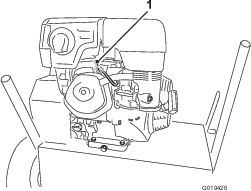
Engine Maintenance
Servicing the Air Cleaner
| Maintenance Service Interval | Maintenance Procedure |
|---|---|
| Before each use or daily |
|
| Every 50 hours |
|
| Every 300 hours |
|
Important: Do not operate the engine without the air filter assembly; extreme engine damage will occur.
-
Park the machine on a level surface, disengage the cutting blades, shut off the engine, and wait for all moving parts to stop, and turn the engine switch to the OFF position.
-
Disconnect the wire from the spark plug.
-
Remove the nut that secures the cover ().
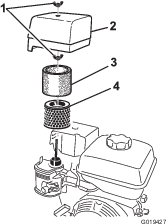
-
Remove the cover.
Note: Be careful to prevent dirt and debris from falling into the base.
-
Remove the nut restraining air filter assembly.
-
Remove the foam and paper elements from the base ().
-
Remove the foam element from the paper element ().
-
Inspect the foam and paper elements, and replace them if they are damaged or excessively dirty.
-
If the paper element is excessively dirty, replace it.
Note: Never try to brush dirt off the paper element; brushing forces the dirt into the fibers.
-
Clean the foam element in warm, soapy water or in a nonflammable solvent.
Note: Do not use fuel to clean the foam element because it could create a risk of fire or explosion.
-
Rinse and dry the foam element thoroughly.
-
Dip the foam element in clean engine oil, then squeeze out the excess oil.
Note: Excess oil in the foam element restricts the air flow through the element and may reach the paper filter and clog it.
-
Wipe dirt from the base and the cover with a moist rag.
Note: Be careful to prevent dirt and debris from entering the air duct leading to the carburetor.
-
Install the air-cleaner elements and ensure that they are properly positioned.
-
Secure the air-cleaner elements with the previously removed nut.
-
Securely install the cover with the previously removed nut.
Checking the Engine-Oil Level
| Maintenance Service Interval | Maintenance Procedure |
|---|---|
| Before each use or daily |
|
-
Park the machine on a level surface, disengage the cutting blades, shut off the engine, and wait for all moving parts to stop, and turn the engine switch to the OFF position.
Note: To ensure a more accurate measurement, adjust the depth control lever until the engine is also level.
-
Clean around the dipstick (Figure 14) so that dirt cannot fall into the filler hole and damage the engine.
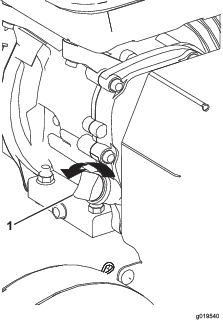
-
Unscrew the dipstick and wipe the end clean (Figure 14).
-
Insert the dipstick fully onto the filler tube. Do not screw in. (Figure 14).
-
Remove the dipstick again and look at the end. If the engine oil level is low, slowly pour only enough oil into the filler tube to raise the level to the upper limit of the dipstick or the bottom edge of the filler tube (Figure 15).

Important: Do not overfill the crankcase with engine oil and run the engine; engine damage may result.
Changing the Engine Oil
| Maintenance Service Interval | Maintenance Procedure |
|---|---|
| After the first 25 hours |
|
| Every 100 hours |
|
Warning
Oil may be hot after the engine has been run, and contact with hot oil can cause severe personal injury.
Avoid contacting the hot engine oil when you drain it.
Oil Type: Detergent oil (API service SJ or higher)
Crankcase Capacity: 1.1 L (37 fl oz)
Viscosity: See table below
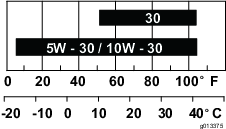
-
Park the machine on a level surface, disengage the cutting blades, shut off the engine, and wait for all moving parts to stop, and turn the engine switch to the OFF position.
-
Disconnect the wire from the spark plug.
-
Raise the front wheels a few inches off the ground and place a pan under the drain plug to catch the oil.
-
Remove the drain plug (Figure 17).
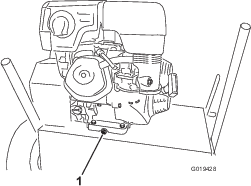
-
When the oil has drained completely, lower the front wheels to the ground, replace the drain plug, and torque to 17 N∙m (13 ft-lb).
Note: Dispose of the used oil at a certified recycling center.
-
Remove the dipstick and slowly pour oil into the filler hole until the oil level reaches the middle of the dipstick (Figure 15).
-
Replace and secure the dipstick.
-
Wipe up any spilled oil.
-
Connect the wire to the spark plug.
Cleaning the Sediment Cup
| Maintenance Service Interval | Maintenance Procedure |
|---|---|
| Every 100 hours |
|
Danger
In certain conditions, fuel is extremely flammable and highly explosive. A fire or explosion from fuel can burn you and others and can damage property.
-
Shut off the engine and keep heat, sparks, and flame away.
-
Handle fuel only outdoors.
-
Wipe up spills immediately.
-
Do not smoke while handling fuel.
-
Park the machine on a level surface, disengage the cutting blades, shut off the engine, and wait for all moving parts to stop, and turn the engine switch to the OFF position.
-
Disconnect the wire from the spark plug.
-
Move the fuel shutoff valve to the Off position.
-
Remove the sediment cup and O-ring (Figure 18).
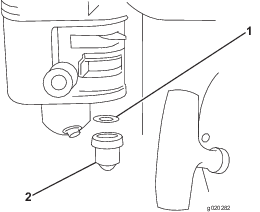
-
Wash the sediment cup in a nonflammable solvent and dry it thoroughly.
-
Place the O-ring in the fuel valve and install the sediment cup, tightening it securely.
-
Move the fuel shutoff lever to the On position.
If any fuel leaks, repeat this procedure and replace the O-ring.
Servicing the Spark Plug
| Maintenance Service Interval | Maintenance Procedure |
|---|---|
| Every 100 hours |
|
| Every 200 hours |
|
Type: NGK BPR6ES or equivalent.
Air Gap: 0.76 mm (0.03 inch)
Removing the Spark Plug
-
Park the machine on a level surface, disengage the cutting blades, shut off the engine, and wait for all moving parts to stop, and turn the engine switch to the OFF position.
-
Disconnect the wire from the spark plug.
-
Clean the area around the base of the plug(s) to keep dirt and debris out of the engine.
-
Remove the spark plug(s) as shown in Figure 19.
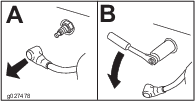
Checking the Spark Plug
Important: Do not clean the spark plug(s). Always replace the spark plug(s) when it has a black coating, worn electrodes, an oily film, or cracks.
If you see light brown or gray on the insulator, the engine is operating properly. A black coating on the insulator usually means the air cleaner is dirty.
Set the gap to 0.76 mm (0.03 inch).
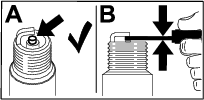
Installing the Spark Plug
-
Carefully install the spark plug by hand (to avoid cross threading) until it is hand tight.
-
Tighten the spark plug an additional 1/2 turn if it is new; otherwise, tighten it an additional 1/8 to 1/4 turn.
Important: A loose spark plug can become very hot and can damage the engine; overtightening a spark plug may damage the threads in the cylinder head.
-
Connect the wire to the spark plug.
Belt Maintenance
Checking the Belt Tension
| Maintenance Service Interval | Maintenance Procedure |
|---|---|
| Before each use or daily |
|
-
Park the machine on a level surface, disengage the cutting blades, shut off the engine, and wait for all moving parts to stop, turn the engine switch to the OFF position, and raise the cutting blades to the transport position.
-
Disconnect the wire from the spark plug.
-
Stop the machine on a level surface, stop the engine by releasing the operator presence bail, disconnect the spark-plug wire,
-
Remove the 4 bolts securing the belt cover to the left side of the machine and remove the cover (Figure 21).
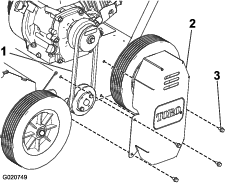
-
Check the tension of the belt (Figure 21).
Note: The belt should not flex more than a 12 mm (1/2 inch) with moderate finger pressure applied to the span just above the machine frame.
-
If the belt tension is loose, refer to Adjusting the Belt Tension.
-
Install the belt cover before operating the machine.
Adjusting the Belt Tension
-
To tighten the belt, loosen the 4 mounting nuts securing the engine to the frame.
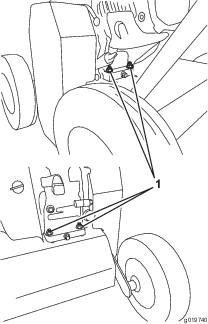
-
Move the engine to tighten the belt to the proper tension.
-
Secure the 4 mounting nuts and bolts.
Note: Torque the bolts that secure the engine to the frame 271 N∙m (200 in-lb).
Blade Maintenance
Replacing Worn Cutting Blades
| Maintenance Service Interval | Maintenance Procedure |
|---|---|
| Before each use or daily |
|
When the cutting blades are worn down and no longer functioning properly, replace them, as follows:
Important: Perform this procedure when the fuel tank is empty or nearly empty. Tip the unit forward to keep air filter up.
-
Park the machine on a level surface, disengage the cutting blades, shut off the engine, and wait for all moving parts to stop, and turn the engine switch to the OFF position.
-
Disconnect the wire from the spark plug.
-
Remove the 4 bolts and 4 nuts securing the belt cover to the left side of the machine, and remove the cover.
-
Remove the cutting blades drive belt from the machine.
-
Tilt the machine forward onto its nose, resting on a block of wood.
Note: It will take 2 people to tip the machine forward safely.
-
Lower the cutting blades to the lowest position.
-
Spin the cutting blade assembly manually.
Note: The blade assembly should spin freely. If it makes a grinding noise and is halting, the bearings are worn; replace them when you replace the blades.
-
Remove the 4 bolts and locknuts securing the cutting blade assembly (Figure 23), and remove it from the machine.

-
Loosen and remove the nut and washer from the shaft (Figure 23).
-
Slide the spacer off the shaft (Figure 23).
-
Carefully slide the blades off the shaft (Figure 23) and replace them as necessary.
-
Reverse this procedure to install the assembly.
Storage
-
Park the machine on a level surface, disengage the cutting blades, shut off the engine, and wait for all moving parts to stop, and turn the engine switch to the OFF position.
-
Disconnect the wire from the spark plug.
-
Remove dirt and grime from the entire machine.
Important: You can wash the machine with mild detergent and water. Do not pressure wash the machine. Avoid excessive use of water, especially near the engine.
-
Service the air cleaner; refer to Servicing the Air Cleaner.
-
Change the engine oil; refer to Changing the Engine Oil.
-
For storage over 30 days, prepare the machine as follows:
-
Add a petroleum based stabilizer/conditioner to fuel in the tank. Follow mixing instructions from stabilizer manufacturer (1 fl oz per gallon). Do not use an alcohol based stabilizer (ethanol or methanol).
Note: A fuel stabilizer/conditioner is most effective when mixed with fresh fuel and used at all times.
-
Run the engine until it stops from running out of fuel.
-
Engage the choke.
-
Start and run the engine until it does not start again.
-
Dispose of fuel properly. Recycle the fuel according to local codes.
Important: Do not store stabilizer/conditioned fuel over 90 days.
-
-
Check and tighten all bolts, nuts, and screws. Repair or replace any part that is damaged.
-
Paint all scratched or bare metal surfaces with paint from an Authorized Service Dealer.
-
Store the machine in a clean, dry garage or storage area.
-
Cover the machine to protect it and keep it clean.
Removing the Machine from Storage
-
Check and tighten all fasteners.
-
Inspect the spark plug and replace it if it is dirty, worn, or cracked; refer to the engine owner’s manual.
-
Install the spark plug until it is hand-tight, then an additional 1/2 turn if it is new, otherwise, tighten it an additional 1/8 to 1/4 turn.
-
Perform any needed maintenance procedures; refer to .
-
Check the engine-oil level; refer to Checking the Engine-Oil Level.
-
Fill the fuel tank with fresh fuel; refer to Filling the Fuel Tank.
-
Connect the wire to the spark plug.
